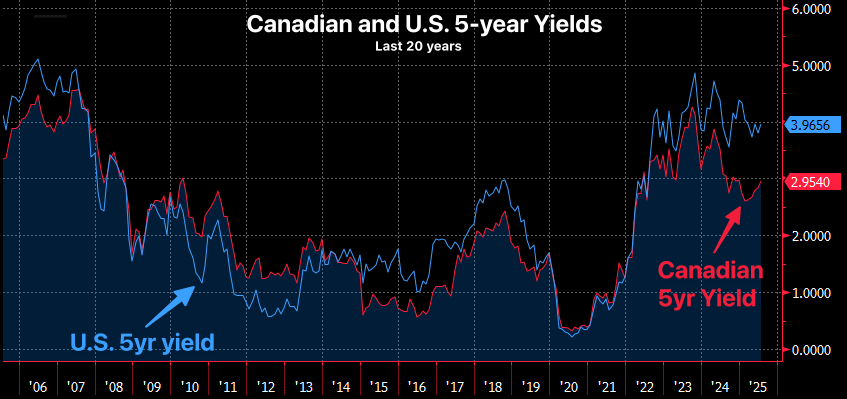Given that fixed mortgage rates are closely tied to government bonds, it’s common for people to wonder why Canadian yields follow U.S. yields like a lost puppy at times.

The answer boils down to three primary forces, which you can remember with the acronym "ACE" (arbitrage, currency, economics):
1. Arbitrage: Global investors are like kids eyeing the best candy. They constantly seek the sweetest returns, adjusted for risk. That's why, when sizing up a government's bonds, they price them—in part—relative to alternatives. The world's #1 alternative is U.S. Treasury bonds, which set a baseline for "risk-free" returns. As a result, Canadian bond investors tend to:
• Demand juicier returns (higher yields) as Treasury yields move up
• Accept slimmer returns (lower yields) as Treasury yields move down.
2. Currency: The Canadian dollar’s value relative to the U.S. dollar also affects bond pricing. Most of the time, rising U.S. yields attract Treasury buyers like moths to a flame. That demand pumps up the U.S. dollar, causing our loonie to decline in relative value. This currency risk, in turn, often forces Canadian bond yields higher to compensate.
3. Economics: Despite 2025's trade spats, North American economies and financial markets are still joined at the hip. Given our trade ties, U.S. growth and inflation usually drive Canadian growth and inflation. Hotter expected inflation puts upward pressure on Canadian yields, while cooler expected inflation does the opposite.
Factoid: Research from the Bank of Canada finds that "U.S. macro news has a more persistent effect on Canadian yields than Canadian news does."
These three triggers explain most of why Canadian yields often rise or fall, even if domestic news doesn’t seem to justify it.
In practice, Canadian bond yields are guided by a balance of global and domestic factors. Apart from America's influence, our bonds take their cues from things like Canadian inflation, domestic currency drivers (oil prices and #BoC# policy), fiscal policy, liquidity, Canadian demand (e.g., from pension funds), and sovereign credit ratings.
Nevertheless, the three catalysts above are mainly why U.S. and Canadian 5-year yields move in parallel over the long run. In fact, their twenty-year monthly correlation is about as strong as you'll find in economics: 0.92 (A perfect correlation = 1.00).
Bonus fact: The 20-year monthly correlation between the Bank of Canada's overnight rate and the U.S. Fed Funds target is even cozier at 0.95, like two peas in a monetary pod.
